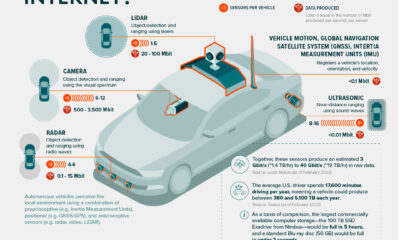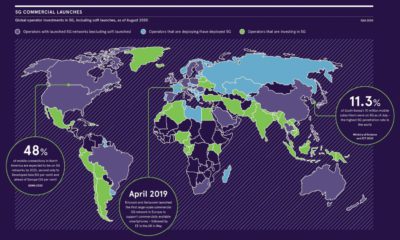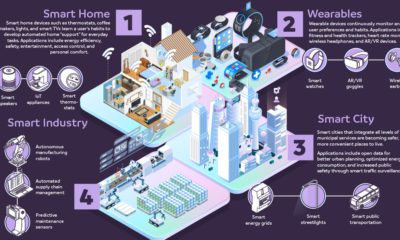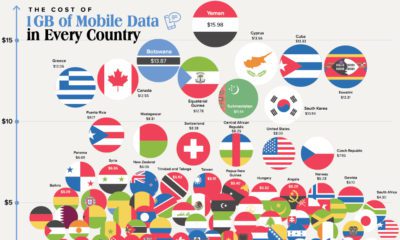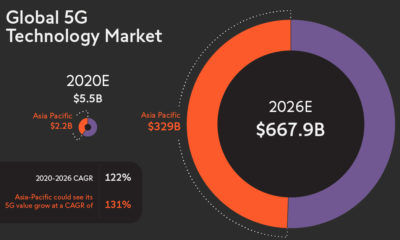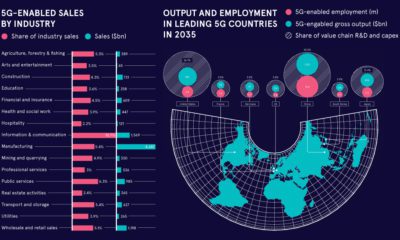The answer depends on the device you’re using, and where in the world you’re located. Average internet speeds vary wildly from country to country.
Which countries have the fastest internet connection? Using data from the Cable.co.uk, this map ranks the fastest (and slowest) internet speeds worldwide by comparing the fixed broadband speeds of over 200 countries.
What Factors Affect Internet Speed?
Before diving in, it’s important to understand the key factors that impact a country’s internet speed. Generally speaking, internet speed depends on: Of course, other factors may influence a country’s internet speed too, such as government regulation and intentional bandwidth throttling, which is the case in countries like Turkmenistan.
Ranked: Fixed Broadband Speeds
To measure fixed broadband speeds across the globe, Cable.co.uk used more than 1.1 billion speed tests, sourced from over 200 countries.
The region with the fastest connection is Jersey, which is one of the islands that make up the British Isles. It has an average download speed of 274.27 mbps—almost 9x the overall average.
Infrastructure is a major reason behind Jersey’s speedy internet. It’s the first jurisdiction in the world to upgrade its entire system to pure fibre (FTTP). But the region’s size also plays a factor, since its landmass and population size are both relatively small compared to the rest of the world.
Second on the list is another small region, Liechtenstein, with an average download speed of 211.26 mbps. Liechtenstein is one of the richest countries in the world per capita, and its government has invested heavily in its telecommunications infrastructure, aiming to be fully fibre optic by 2022.
Like Jersey, Liechtenstein also has a relatively small population. At the time of this article’s publication, the region is home to approximately 38,000 people. In fact, it’s worth noting that of the top ten regions, only two have populations over one million—the Netherlands, and Hungary.
At the opposite end of the spectrum, Turkmenistan has the slowest fixed broadband, with a speed of 0.5 mbps. As mentioned above, this is largely because of government regulation and intervention.
The Future is 5G
Innovation and new technologies are changing the digital landscape, and things like 5G networks are becoming more mainstream across the globe. Because of the rapidly changing nature of this industry, the data behind this ranking is updated monthly to provide the latest look at internet speeds across the globe. This means the bar is gradually raising when it comes to internet speed, as faster, stronger internet connections become the norm. And countries that aren’t equipped to handle these souped-up networks will lag behind even further. on But fast forward to the end of last week, and SVB was shuttered by regulators after a panic-induced bank run. So, how exactly did this happen? We dig in below.
Road to a Bank Run
SVB and its customers generally thrived during the low interest rate era, but as rates rose, SVB found itself more exposed to risk than a typical bank. Even so, at the end of 2022, the bank’s balance sheet showed no cause for alarm.
As well, the bank was viewed positively in a number of places. Most Wall Street analyst ratings were overwhelmingly positive on the bank’s stock, and Forbes had just added the bank to its Financial All-Stars list. Outward signs of trouble emerged on Wednesday, March 8th, when SVB surprised investors with news that the bank needed to raise more than $2 billion to shore up its balance sheet. The reaction from prominent venture capitalists was not positive, with Coatue Management, Union Square Ventures, and Peter Thiel’s Founders Fund moving to limit exposure to the 40-year-old bank. The influence of these firms is believed to have added fuel to the fire, and a bank run ensued. Also influencing decision making was the fact that SVB had the highest percentage of uninsured domestic deposits of all big banks. These totaled nearly $152 billion, or about 97% of all deposits. By the end of the day, customers had tried to withdraw $42 billion in deposits.
What Triggered the SVB Collapse?
While the collapse of SVB took place over the course of 44 hours, its roots trace back to the early pandemic years. In 2021, U.S. venture capital-backed companies raised a record $330 billion—double the amount seen in 2020. At the time, interest rates were at rock-bottom levels to help buoy the economy. Matt Levine sums up the situation well: “When interest rates are low everywhere, a dollar in 20 years is about as good as a dollar today, so a startup whose business model is “we will lose money for a decade building artificial intelligence, and then rake in lots of money in the far future” sounds pretty good. When interest rates are higher, a dollar today is better than a dollar tomorrow, so investors want cash flows. When interest rates were low for a long time, and suddenly become high, all the money that was rushing to your customers is suddenly cut off.” Source: Pitchbook Why is this important? During this time, SVB received billions of dollars from these venture-backed clients. In one year alone, their deposits increased 100%. They took these funds and invested them in longer-term bonds. As a result, this created a dangerous trap as the company expected rates would remain low. During this time, SVB invested in bonds at the top of the market. As interest rates rose higher and bond prices declined, SVB started taking major losses on their long-term bond holdings.
Losses Fueling a Liquidity Crunch
When SVB reported its fourth quarter results in early 2023, Moody’s Investor Service, a credit rating agency took notice. In early March, it said that SVB was at high risk for a downgrade due to its significant unrealized losses. In response, SVB looked to sell $2 billion of its investments at a loss to help boost liquidity for its struggling balance sheet. Soon, more hedge funds and venture investors realized SVB could be on thin ice. Depositors withdrew funds in droves, spurring a liquidity squeeze and prompting California regulators and the FDIC to step in and shut down the bank.
What Happens Now?
While much of SVB’s activity was focused on the tech sector, the bank’s shocking collapse has rattled a financial sector that is already on edge.
The four biggest U.S. banks lost a combined $52 billion the day before the SVB collapse. On Friday, other banking stocks saw double-digit drops, including Signature Bank (-23%), First Republic (-15%), and Silvergate Capital (-11%).
Source: Morningstar Direct. *Represents March 9 data, trading halted on March 10.
When the dust settles, it’s hard to predict the ripple effects that will emerge from this dramatic event. For investors, the Secretary of the Treasury Janet Yellen announced confidence in the banking system remaining resilient, noting that regulators have the proper tools in response to the issue.
But others have seen trouble brewing as far back as 2020 (or earlier) when commercial banking assets were skyrocketing and banks were buying bonds when rates were low.
